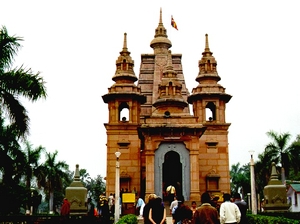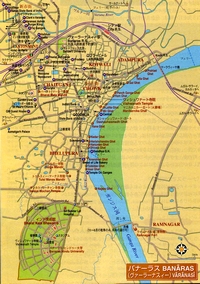

Bodaiju Tours (P) Ltd.

................................................
>> TRAVEL TOOLS
Copyright 2006 Bodaiju Tours (P) Ltd. All Rights Reserved.
>> SPECIAL TOURS
Varanasi is said to be the most holy city in Hinduism. Varanasi is the site of the holy shrine of Lord Kashi Vishwanath (an incarnation of Lord Shiva), one of the twelve revered Jyotirlingas of the Lord Shiva. Kashi Vishwanath Temple, which in its present shape was built in 1780 by Maharani Ahilyabai Holkar of Indore, is located on the banks of the Ganges. This temple makes Varanasi a place of great religious importance to the Hindus. Varanasi is considered as the most sacred place of pilgrimage for Hindus irrespective of denomination.
It is believed that bathing in the river Ganges results in the remission of sins and that dying in the holy city of Kasi (Varanasi) circumvents rebirth. This belief has encouraged the establishment of geriatric homes and hospices in the city, and led to the disposal of half-burnt corpses into the river Ganges. This practice continues to cause immense damage to the river's ecology (see Ganges' pollution problems). The ministry of water resources has banned cremation on the city's ghats (ghats are the banks of a holy river, and often, as at Varanasi, steps are built to facilitate bathing). However, cremations are still happening day and night in large numbers. (As of March 2006.) Tourists may even be allowed to attend from up close by the defunct's family and take photographs against the purchase of a certain quantity of cremation logs.
View of evening prayers at VaranasiIn the residential neighborhood of the city lies Sarnath, the site of the deer park where Gautama Buddha is said to have given his first sermon about the basic principles of Buddhism. It is a major Buddhist pilgrimage center and also has a stupa built by the Maurya emperor Ashoka the Great.
The name Varanasi is derived from two tributaries of the Ganges, one in the north end of the city, called Varun? and the other in the south end, called Assi (now reduced to a water-drain). The city has an airport at Babatpur, 20 km from the city centre, and is also well-connected to all major cities in India by road and rail.
Regions near the banks of river Ganges are extremely crowded and house several Hindu temples, narrow winding lanes and road-side shops. The main residential areas of Varanasi (especially for the middle and upper classes) are situated in regions far from the ghats; they are more spacious and less polluted. Such a place in an Indian city is called a housing colony.
Probably due to its unique culture, Varanasi is a major tourist destination for foreign tourists in India. The city has also been influenced by Islamic culture. A symbol of Hinduism, the city was pillaged and destroyed several times by the Muslims, first by the hordes of Mahmud of Ghazni in 1033, all Hindu temples beeing destroyed. The material was used to build mosques. The latter destruction was led by the Moghul emperor Aurangzeb, who renamed the city Mohammadabad.
This explains the continuous tensions between comunities in the city and the fact that really ancient monuments are few. However, Varanasi has kept its sacred position as the Holy City of Hinduism.
Varanasi and Sarnath Guide Book
Sarnath
The Buddha went to Sarnath from Bodh Gaya after his enlightenment. He was seeking his five former companions. Having found them he taught them and they also became enlightened, and hence the Sangha, or community of the enlightened ones, was founded. The Buddha spent the next rainy season in Sarnath at the mulagandhakuti vihara. The Sangha having grown to 60 in number, the Buddha sent them out in all directions to teach the Dharma.
The first five disciples pay respects to the Wheel of the Dhamma at the deerpark of Isipatana.
Buddhism flourished in Sarnath in part because of kings and wealthy merchants based in Varanasi. By the third century Sarnath had become an important center for the arts, which reached its zenith during the Gupta period (4th to 6th centuries CE). In the 7th century by the time Xuan Zang visited from China, he found 30 monasteries and 3000 monks living at Sarnath.
Sarnath became a major centre of the Sammatiya school of Buddhism, one of the Nikaya or Hinayana schools. However, the presence of images of Heruka and Tara indicate that Vajrayana Buddhism was also practiced here.
Sarnath ruinsAt the end of the 12th century Sarnath was sacked by Turkish Muslims, and the site was subsequently plundered for building materials.
Features
All of the ancient buildings and structures at Sarnath were damaged or destroyed by the Turks. However, amongst the ruins the Dhamekh Stupa is an impressive 128 feet high and 93 feet in diameter. The Dharmarajika Stupa is one of the few pre-Ashokan stupas remaining, although only the foundations remain.
Murals inside the Mulagandhakuti Vihara
Murals inside the Mulagandhakuti ViharaThe decaying ruins of the Mulagandhakuti vihara mark the place where the Buddha spent his first rainy season while to the east is the modern Mulagandhakuti Vihara with its beautiful wall paintings and behind it the Deer Park (where deer are still to be seen).
The Ashoka pillar was broken some time ago but the base still stands. The lion capital, which miraculously survived its 45 foot drop to the ground, became a symbol on the Indian flag, and is still on display at the Sarnath Archeological Museum which also houses some of the greatest treasures of Indian Buddhist art including almost 300 images.
There is also a Bodhi tree planted by Anagarika Dharmapala which was grown from a cutting of the Bodhi tree at Bodh Gaya.
For Buddhists, this is one of four pilgrimage sites designated by Gautama Buddha, the other three being Kushinagar, Bodh Gaya, and Lumbini.


Contact for more information
>> WHAT'S NEW?
Dubai Package tours
Sri Lanka Package tour
Nepal Package tour
Maldives Package tour
Flight Over the world
Private Jet
